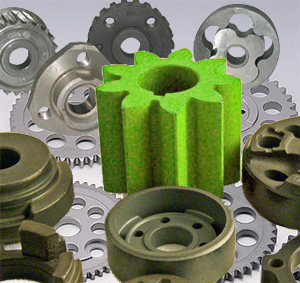Copper Powder for Metallurgy
Powder metallurgy is a forming and fabrication technique
using metal powders. In powder metallurgy, initially the
powder is injected into a mold or passed through a die to produce a weakly
cohesive structure (via cold welding) very near the dimensions of the object
ultimately to be manufactured. Pressures of 10-50 tons per square inch are
commonly used.
Finally, the parts are placed in a kiln, applying high temperature, during which self-welding occurs
without melting.
Copper powder alone or in a mixture with other metal powders is used in powder
metallurgy for making different metal parts.
Metal powders open up new possibilities for creative and cost-effective design solutions.
Over 40 million sintered components are produced every day for use in numerous applications including vehicles, power tools and white goods.
The automotive industry
is the main user of sintered components, which are common in transmission and
engine applications. It is in the automotive area that sintered components have
made the most spectacular advances. Many of the early parts for vehicles, such
as the bushings and bearings introduced in the 1960s were simple shapes.
Components of today can be made in highly complex designs and meet the
industry's demands for strength and tolerances.
A modern automobile contains on average 10 kg of sintered components, but there
are big variations depending on its origin. US automobiles tend to have far more
sintered components than those produced in Asia.
The use of sintered components is increasing outside the automotive sector, but
there is still a huge potential. Parts produced from powder serve special
functions
in power tools, white goods, appliances, air-conditioners, computers, lawn
movers, locks and pumps. These are just a few examples and the possibilities are
endless.

